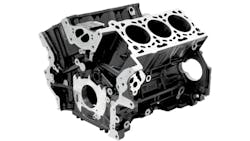Chrysler Group will offer its 3.0-liter V6 EcoDiesel engine with a compacted graphite iron (CGI) block as an option for its 2014 Jeep Grand Cherokees and Dodge Ram 1500 pick-up trucks, as noted by SinterCast AB in a release. The new vehicle options will become available during Q3 2013.
These new options show the progress of CGI in the North American vehicle market, in particular via the increase in diesel-powered cars and trucks. The 2014 Dodge Ram 1500 will be the first diesel engine offered in a half-ton pick-up.
CGI is a lightweight alternative to gray iron and aluminum for automotive component manufacturing. SinterCast developed the most widely used process for commercial CGI production. It’s now under license to numerous automotive foundries worldwide and used to cast nearly 50 different components in series production. A scaled version of the technology has been adopted by several research centers around the world, too.
VM Motori S.p.A., a diesel engine specialist in Cento, Italy, co-owned by Chrysler parent Fiat S.p.A., builds Chrysler’s 3.0-liter V6 EcoDiesel. The foundation of the diesel engine is a CGI cylinder block cast at the Tupy foundry in Joinville, Brazil. Tupy is a SinterCast licensee, and operates CGI production lines at its engine foundries in Mexico as well as Brazil.
The V6 EcoDiesel has been in production since 2010 for the European version of the Jeep Grand Cherokee, Chrysler 300, and Lancia Thema.
According to SinterCast, Tupy increased series production of the V6 EcoDiesel cylinder blocks and bedplates in the second half of 2012, in anticipation of Chrysler’s plan to add the new option for its North American Jeep and pickup truck lines. It added that it foresees Tupy’s output of CGI for the Chrysler engines will exceed 5,000 metric tons (“100,000 engine equivalents”) during 2013.
Diesel momentum
SinterCast tabulates CGI production as “engine equivalents,” with each engine representing 50 Kg of compacted graphite iron produced under its license.
In North America, the expansion of CGI engines is an effect of the growing number of diesel engine options planned by automakers. Diesel engines typically offer fuel-economy savings averaging 30% above comparable vehicles’ gasoline engine alternatives. Diesel options for U.S. passenger cars typically garner over 30% of sales, according to a SinterCast citation.
Volkswagen has seen U.S. sales of diesel versions of compact vehicles (like the VW Jetta rise to about 20% of the total) and General Motors will add a new 2.0-liter turbo diesel option for its Chevrolet Cruze later this year
In addition to Chrysler’s 2014 plans, Audi plans to offer diesel engine versions of its A6, A7, A8 and Q5 vehicles.
Heavy-duty pick-ups have featured diesel options for some time already, and according to SinterCast’s reference the diesel versions of HD pick-ups command more than 60% their respective market shares. Thus, the emergence of diesel in the light-duty pick-up sector is recognized as an important commercial development.
"Despite media focus on vehicle downsizing and electrification, pick-ups remain the best-selling vehicles in the U.S.,” observed SinterCast president and CEO Dr. Steve Dawson, who added that “the first diesel offering in the half-ton sector will undoubtedly lead to increased sales for Ram, and set a competitive benchmark for the other OEMs to respond to …
“Together with the previously announced commitment for the first-ever high-volume CGI petrol engine, with start of production in 2013 the Ram announcement represents a second breakthrough for SinterCast in 2013, providing a strong foundation for continued growth," he concluded.
About the Author
Robert Brooks
Content Director
Robert Brooks has been a business-to-business reporter, writer, editor, and columnist for more than 20 years, specializing in the primary metal and basic manufacturing industries. His work has covered a wide range of topics, including process technology, resource development, material selection, product design, workforce development, and industrial market strategies, among others.
